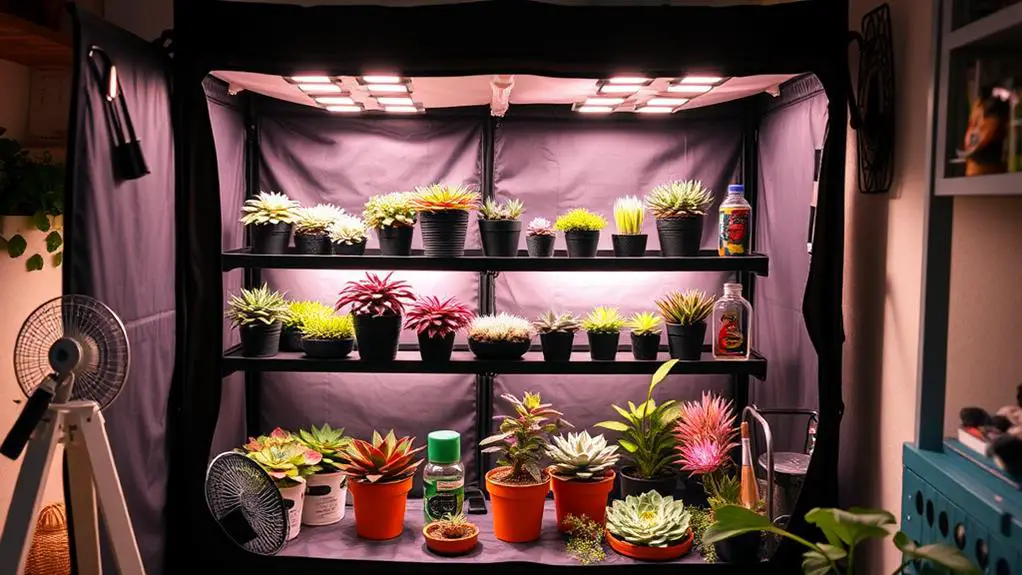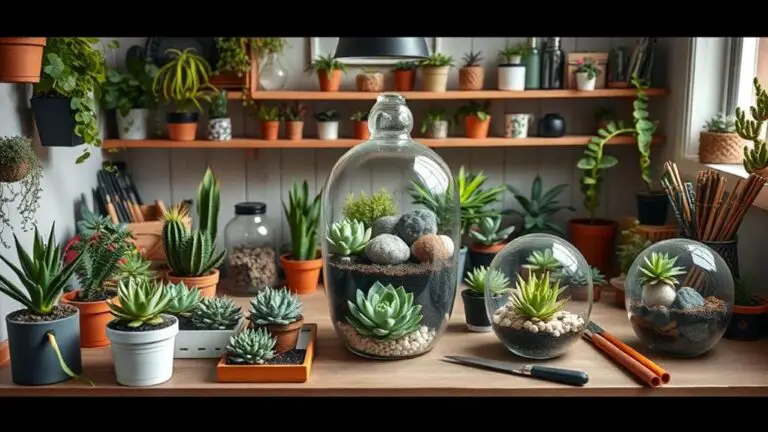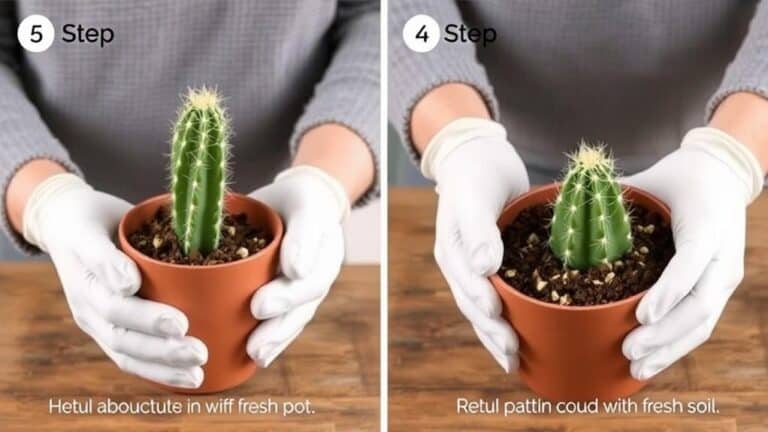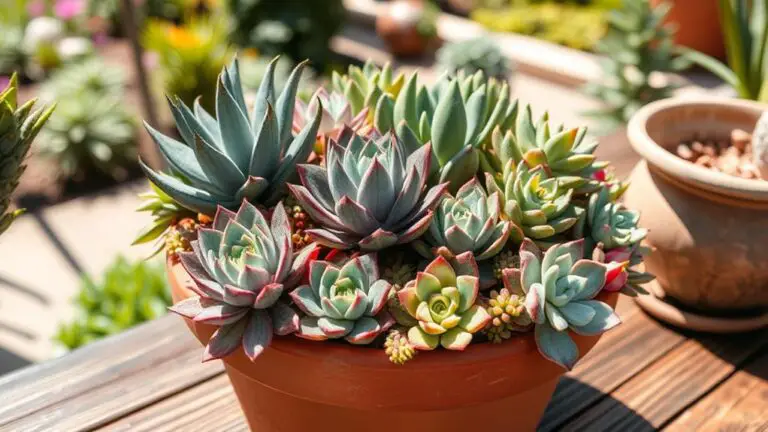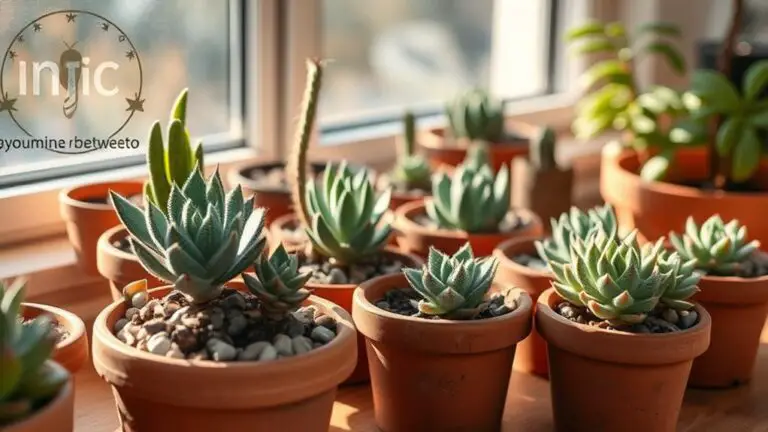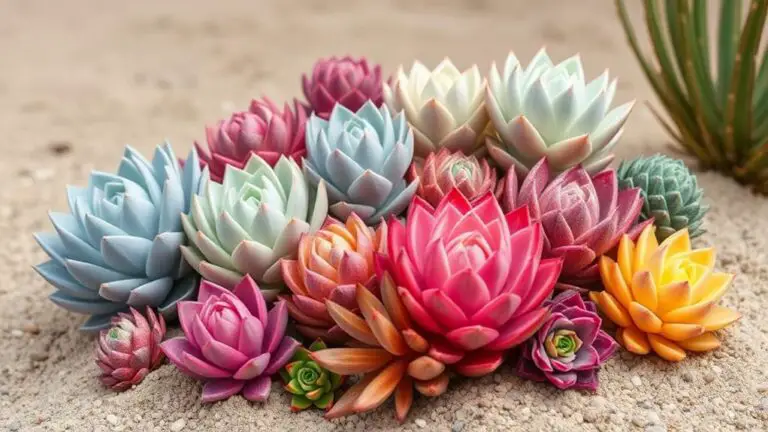7 Steps to Setting Up a Grow Tent for Indoor Succulents
When you're ready to set up a grow tent for your indoor succulents, understanding the seven essential steps can make a significant difference in their health and growth. First, you'll need to pick the right tent with a light-proof fabric and reflective interiors to maximize light efficiency. Once you've gathered all the necessary tools and assembled the tent, it's important to install a proper ventilation system. After setting up the grow lights at the ideal height, configuring the timer settings for both lighting and ventilation is critical. But that's not all; consistent monitoring and maintenance are key to success. Curious about the specifics? Let's get started.
Choose the Right Tent

When setting up a grow tent for your indoor succulents, choosing the right tent is vital. You want a grow tent that balances affordability and quality features. For example, the Galaxy Grow Tent offers durable construction with light-proof fabric panels to prevent any light leakage. This is significant because proper light control helps your succulents thrive.
Selecting the right size is also important. If you have many succulents, a larger tent like a 4×8' might be perfect. These can be found for just over $300, which is a bargain compared to other brands that can cost more than $500.
It's also important to take into account the tent's interior. Look for reflective interiors to maximize light efficiency. This guarantees your succulents get the light they need for indoor growing.
Don't forget about ventilation. A good ventilation system is vital for adequate airflow, which helps maintain the right humidity levels and prevents soil rot.
Lastly, choose a tent with multiple access points. Having two front doors and two side doors makes it easier to monitor and care for your succulents. This way, you can check on them and make adjustments as needed without any hassle.
Gather Necessary Tools

Choosing the right grow tent is just the first step; now you need to gather the necessary tools to set it up efficiently.
Start with a tape measure to confirm accurate measurements of both the tent and your designated space. This will help you avoid any surprises during the setup.
Next, have wire cutters or pliers on hand. These tools are vital for cutting any ducting to fit your ventilation system properly.
You'll also need a flathead screwdriver. This tool is essential for securely attaching ventilation components such as the fan and filter. Confirming proper ventilation is key to creating a healthy environment for your succulents.
Before diving into the setup, prepare a clean workspace. Keeping your tools and components organized will make the process smoother and less stressful.
Assemble the Tent

To kick off assembling your grow tent, lay out all the components in your workspace. Confirm you have the frame, cover, and supports for lights and ventilation ready for setup. This will help you stay organized and guarantee you don't miss any parts.
Next, follow the instruction manual to connect the frame pieces. Typically, this takes around 15 to 30 minutes. Securely attach the cross bars to distribute weight evenly. This step is essential for keeping your grow tent stable and safe for your indoor succulents.
Once your frame is up, carefully drape the tent cover over the structure. Align all zippers and openings correctly. This guarantees you'll have easy access later when you need to check on your plants or adjust the setup.
Place the tent in a clean, insulated area with stable temperature. Keep it out of direct sunlight to maintain consistent conditions for your succulents.
Install Ventilation System

With your grow tent assembled and in place, it's time to focus on the ventilation system. Proper air circulation is key for keeping your succulents healthy.
First, install an inline fan inside the tent. This fan will help move air around and prevent humidity issues that could harm your plants.
Next, add a carbon filter to your fan and filter setup. The carbon filter will remove any odors and improve the air quality inside the tent. This is especially important if your grow tent is in a shared living space.
Now, measure and cut the ducting to the right length. Accurate measurements are essential for maintaining good airflow. Connect the fan and carbon filter using the ducting. Make sure the fan is placed near the top of the tent. This positioning allows it to expel warm air generated by grow lights, while cooler air is drawn in from the bottom.
Remember to regularly check and clean your ventilation system. Dust and debris can build up, reducing its efficiency.
Keeping the fan and filter clean guarantees peak performance, helping your succulents thrive. Proper air circulation and air quality will create the best environment for your indoor garden.
Set Up Grow Lights

Installing grow lights correctly is vital for the success of your indoor succulent garden. First, you'll need to set up a grow light system that guarantees stability and efficiency. Use two hangers per light and attach hooks to the crossbar at the top of the tent for secure placement. This setup will keep your lights steady and well-positioned.
Choose LED grow lights for your tent. They convert 80-90% of light into usable energy for your plants and emit low heat, making them perfect for indoor spaces. Position the lights at the right height above your succulents, usually around 12-24 inches, depending on the light intensity. You can adjust the height using ratchet ropes to maintain the ideal distance as your succulents grow.
To automate your lighting, connect the grow lights to a timer outlet. This will help you maintain consistent light cycles, which are essential for your succulents' health.
Regularly check the light spectrum of your LEDs. Succulents thrive with a balanced light spectrum that includes blue and red light, supporting their growth stages effectively.
With these steps, you'll have a well-lit grow tent ready for your succulents to flourish.
Configure Timer Settings
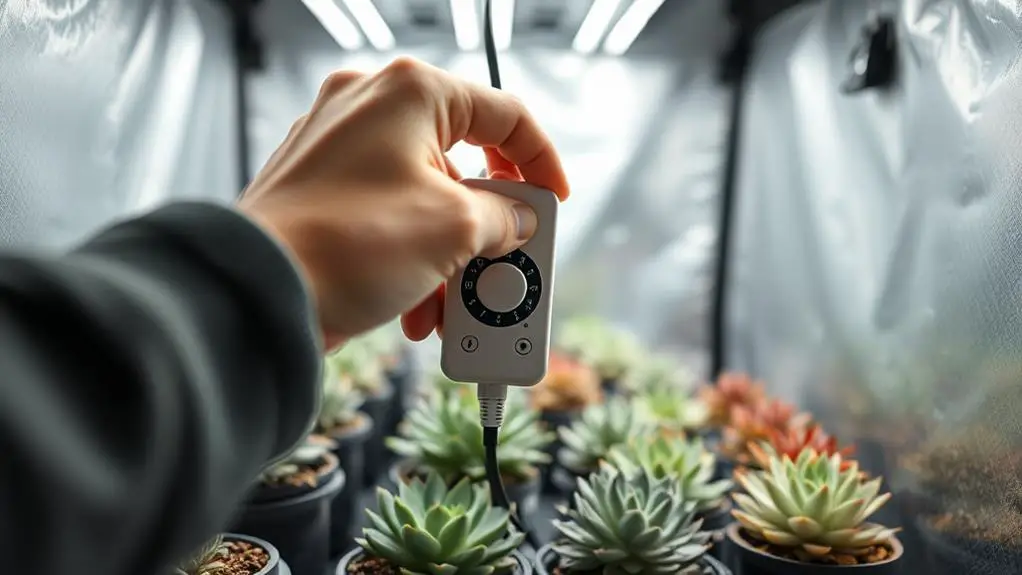
To configure timer settings, plug your grow lights and fans into timer outlets connected to a 120V wall socket or power strip.
Set your grow lights to run for 12-16 hours a day to mimic natural sunlight and use digital timers for precise control.
Don't forget to also automate your ventilation cycles to keep your succulents healthy and thriving.
Choosing Appropriate Timers
Setting up the right timers for your grow lights is essential to guaranteeing your indoor succulents get the best amount of light they need to thrive. Your plants will benefit greatly from a consistent lighting schedule, and a complete grow tent kit with timer settings will help you create a controlled environment.
Aim for 12-16 hours of light per day during the growing season to mimic natural sunlight exposure.
Digital timers are a great choice for precision. They allow you to adjust settings easily for different growth stages. For example, during the active growing phase, you might need to increase the light duration. Set your timers to turn on the LED lights in the morning and off in the evening to establish a routine that supports healthy growth.
Make sure the timers you choose are rated to handle the wattage of your grow lights. This will prevent overheating and potential failure. Always check compatibility before purchasing.
Additionally, remember to regularly check and reset the timer settings during seasonal changes. This guarantees your succulents get ideal conditions year-round.
With the right timers, your indoor garden can flourish beautifully, providing the perfect balance of light and a steady water supply.
Setting Light Schedules
When configuring your timer settings for grow lights, start by establishing a consistent light schedule that mimics natural sunlight. Set your grow lights on a timer to provide 12 to 16 hours of light per day, which is ideal for most succulents during their active growing season.
Use digital timers for precise control, letting you program different schedules based on your plant's growth stage and seasonal changes.
Position the timer outlet close to the power source. This minimizes excess cord length and reduces trip hazards in your indoor grow room. Regularly check your timer settings to verify they haven't been accidentally altered. Consistent light exposure is vital for the health of your succulents.
If you're shifting your plants from lower to higher light needs, adjust the light duration gradually. This helps prevent stress or shock to your plants.
Use the best grow lights and light hangers to guarantee peak light distribution and growth. Remember, setting up a grow tent properly means your succulents will thrive.
With the right timer settings, you can grow your plants successfully, making sure they get the light they need while you enjoy the benefits of fresh air and greenery indoors.
Automating Ventilation Cycles
Although setting up a grow tent for succulents can seem intimidating, automating the ventilation cycles is key to guaranteeing ideal air circulation and humidity control. By automating ventilation cycles, you make certain your succulents get fresh air and maintain the right relative humidity.
Start by using a digital timer to program the ventilation setup. Set the timer to run for 15-30 minutes every hour. This helps in providing consistent air movement and prevents humidity from getting too high.
Plug the in-line fan into the timer outlet and connect the timer to a 120V wall socket or power strip. This guarantees reliable operation.
Keep an eye on the environmental conditions inside the grow tent. Adjust the timer settings as the seasons change because temperature and humidity levels can fluctuate. Regularly monitoring these conditions will help you maintain peak airflow and prevent heat buildup, which can stress your plants.
Final Checks and Maintenance

Now that your grow tent is set up, let's make certain everything's working perfectly.
Check all electrical connections to verify they're secure and safe.
Monitor the temperature and humidity inside the tent to keep your succulents happy and healthy.
Verify Electrical Connections
Before you activate your grow tent system, double-checking all electrical connections is important. You'll need to verify that every connection is secure and properly wired to prevent short circuits or electrical fires.
Make sure power cords are routed through designated cord holes to avoid damage and keep your setup tidy. This step is significant to maintaining the safety and efficiency of your grow tent.
Inspect the integrity of timers and other electrical components. Verify they're working correctly and can provide accurate scheduling for your lights and ventilation. A reliable timer is key to keeping your succulents healthy with consistent light and air cycles.
Conduct a test run of your entire system. Let it run for at least one hour to monitor for any potential issues, such as heat buildup or light leaks. This test will help you identify and fix problems before they can affect your plants.
Regular maintenance is essential. Regularly check your electrical connections for wear or damage. Doing this guarantees continued safety and efficiency in your grow tent setup.
Keeping everything in top shape will help your succulents thrive indoors. Remember, a little extra effort now can save a lot of trouble later.
Monitor Environmental Conditions
Making sure the ideal environment inside your grow tent is essential for thriving succulents. To start, regularly check the temperature and humidity levels using a digital thermometer and hygrometer. Aim for a temperature range of 65°F to 80°F and keep humidity between 40% and 60%.
| Task | Tool Needed |
|---|---|
| Check temperature | Digital thermometer |
| Monitor humidity | Digital hygrometer |
| Measure light | Light meter |
Next, monitor light intensity and duration with a light meter. Succulents need 12-16 hours of light daily. Too much light can cause sunburn, so balance is key. Also, make certain proper air circulation to avoid mold and pests.
Inspect soil moisture levels consistently. Use a moisture meter or check the top inch of soil by touch. Overwatering can lead to root rot, so keep the soil lightly moist. Conduct weekly visual inspections for pests or diseases. Look for signs like discoloration or wilting and act quickly if you spot any issues.
Lastly, maintain cleanliness in your grow tent. Remove fallen leaves and debris to prevent mold growth. Cleanliness makes certain a healthy environment for your succulents. By following these steps, you'll create an ideal space for your plants to flourish.
Frequently Asked Questions
Can You Grow Succulents in a Grow Tent?
Absolutely, you can grow succulents in a grow tent. It provides a controlled environment, optimizes light, and improves air circulation, ensuring your succulents thrive year-round without worrying about harsh outdoor conditions or pests.
How Do I Set up My Grow Tent?
To set up your grow tent, choose a clean, insulated area with access to electricity and water. Measure the space, assemble the tent, set up the ventilation system, and install your grow lights centrally using adjustable hangers.
What Is Needed for an Indoor Grow Tent?
You'll need a suitable grow tent, quality LED lights, a ventilation system, a timer, ducting, an inline fan, and a removable fabric tray. These essentials guarantee ideal growth, airflow, and easy maintenance for your indoor succulents.
How to Build a Grow Room Step by Step?
To build a grow room, choose a clean, insulated space with water and electricity access. Measure accurately, assemble the tent, install ventilation and lighting, and monitor temperature and humidity. Regularly check conditions to guarantee plant health.
Conclusion
You've got this! Setting up a grow tent for your indoor succulents might seem overwhelming at first, but by following these steps, you'll create a perfect environment for them. Remember to choose the right tent, gather your tools, and carefully set up your ventilation and lighting systems. Don't forget to configure your timers and keep an eye on conditions inside the tent. With regular maintenance, your succulents will thrive. Happy gardening!

